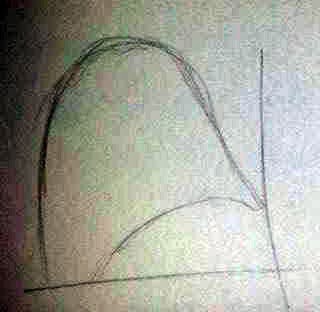Before, I started to create my flip book we went through the 12 principals of animation that were created by Frank Thomas and Ollie Johnston, members of an early Disney animation team (no surprise there…). They go through the key fundamentals of what to consider when creating an animation, which I found extremely useful. Although we learnt about all 12 principals, the task yesterday focused upon only 8 of these principals (thinking about it that's actually quite a few considering we were only animating a ball). The most important I focused upon were, squash and stretch, timing and ease-out and ease-in.
By using SQUASH and STRETCH I was able to give the illusion of weight and volume to my work, which made my flip book a lot more effective than if I'd have just made my ball touch the line and move back up the page. Also, using this principal gave my ball a lot more fluidity and made the flip book more interesting to watch.
Surprisingly enough though it was really difficult to keep the volume of the ball constant throughout the frames, especially when it came to stretching and squashing the ball.
 |
| Stretch |
 |
| Squash |
Moving on…
The TIMING of the whole flip book was extremely important in making it a successful animation too. The spacing of each drawing had to be correct otherwise the fall would either look too slow or too fast. This, at first, seemed like it was challenging however, after getting my head around the idea that drawings closer together slowed down an action and drawings further apart sped up the action I found that it was quite easy to space the drawings out or clump them together where necessary (I never said I did it perfectly though). Again, once I got a handle on the timing I found that it made my flip book a lot more successful and made it run smoothly.
Similarly to timing, EASE-OUT and EASE-IN focus upon the amount of drawings at the start and end of an action. As an action begins there will be more drawings, few in the middle and more at the end. By using this principal it makes the transition from stand still to action a lot smoother and easier to follow.
 |
| Poor quality, rough sketch of timing and easing-out and easing-in. |
Okay, for the second flip book (the ball bouncing around the page) we focused upon the previous principals as well as the principal of ARCS. All actions (with the exception of mechanical ones) follow an arc or circular path, this includes a bouncing ball. I found that, by applying this principal, my flip book flowed really well and the action appeared more natural.
 |
| Again, a very poor quality sketch of arc path ball will take. |
We also looked at the principal of ANTICIPATION. This communicates what's going to happen and is preparation for action. In other words it is a small, slower movement or action that a character or object makes before a major action, which will most likely be faster. for my task the anticipation of the ball looks the exact same as stretching and squashing just in a different order. The ball would squash before stretching.
Now to move on with adding 'character' to the ball...
I feel that the adding character element of the task went well however, I do need to work on my overlapping a bit more. Good result for a first attempt though.




No comments:
Post a Comment